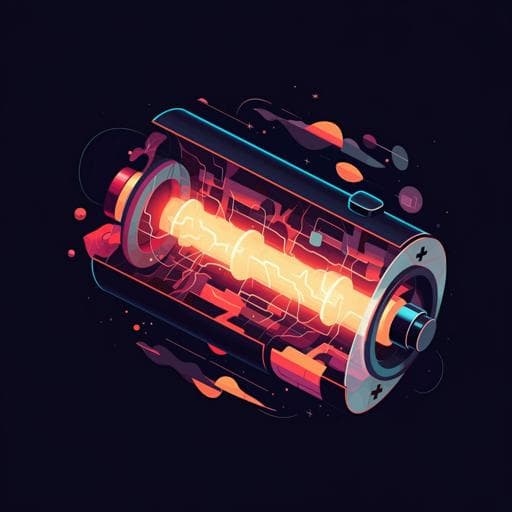
Engineering and Technology
Identifying degradation patterns of lithium ion batteries from impedance spectroscopy using machine learning
Y. Zhang, Q. Tang, et al.
Unlock the secrets of Li-ion battery health and lifespan with groundbreaking research from Yunwei Zhang, Qiaochu Tang, Yao Zhang, Jiabin Wang, Ulrich Stimming, and Alpha A. Lee. This study introduces a pioneering system that combines electrochemical impedance spectroscopy and Gaussian process machine learning, utilizing an extensive dataset of over 20,000 EIS spectra to predict battery degradation accurately.
~3 min • Beginner • English
Introduction
Lithium-ion batteries underpin modern technologies due to their high energy and power density, yet predicting battery degradation remains challenging. Accurate prediction of state of health (SoH) and remaining useful life (RUL) is crucial to prevent unexpected capacity fade, inform replacement decisions, and enable efficient recycling pathways including second-life applications. Traditional forecasting relies on modelling microscopic degradation mechanisms (e.g., SEI growth, lithium plating, active material loss), which offers physical insight but is unscalable for comprehensive diagnosis. Data-driven approaches bypass explicit mechanistic modelling by linking real-time, non-invasive measurements to battery health via statistical learning, but their success hinges on informative inputs and robust models. While features from charge/discharge curves are commonly used due to availability in battery management systems, electrochemical impedance spectroscopy (EIS) contains richer information across frequencies but is high-dimensional, complicating feature selection. Prior work often reduces EIS via equivalent circuit fits or selected frequencies, which can be non-unique or handpicked. Recent machine learning advances allow models to ingest entire datasets and learn salient variables automatically; such models have been used with current-voltage data to predict capacity, SoC, and cycle life. However, late-stage behaviour forecasting from early-life data remains difficult. This study demonstrates that Gaussian process regression (GPR) using full EIS spectra can accurately estimate capacity and predict RUL across states of charge and temperatures, outperforming discharge-curve-based methods and attributing predictions to specific frequencies.
Literature Review
Conventional physics-based models target specific degradation processes such as SEI growth, lithium plating, and active material loss, but comprehensive characterization is impractical. Data-driven methods using charge/discharge curves (incremental capacity analysis, differential voltage analysis, predictive analytics) have shown promise for SoH and cycle life estimation. EIS has long been recognized as informative for SoH/SoC and degradation tracking, but deployment is limited by spectrum dimensionality and ambiguity in equivalent circuit model fitting. Previous EIS-based studies often rely on circuit fitting, symmetric cell approaches, or single-/multi-point impedance diagnostics. Machine learning has been applied to aid EIS inverse models and to forecast capacity and SoH using charge/discharge data via GPR and other models. This work departs from prior art by directly using full EIS spectra as inputs to GPR with automatic relevance determination (ARD) to identify salient frequencies without hand-engineered features, enabling accurate capacity and RUL prediction.
Methodology
Experimental data: Twelve commercial 45 mAh Eunicell LR2032 Li-ion coin cells (LiCoO2/graphite) were cycled in climate chambers at 25 °C (25C01–25C08), 35 °C (35C01–35C02), and 45 °C (45C01–45C02). Protocol per cycle: 1C (45 mA) CC–CV charge to 4.2 V, then 2C (90 mA) CC discharge to 3 V. EIS was measured at nine stages during every even-numbered cycle over 0.02 Hz–20 kHz with 5 mA excitation, following a 15-min open-circuit rest; capacity was measured after every odd-numbered cycle. Cells first underwent 30 cycles at 25 °C; end of life (EoL) defined as capacity below 80% of initial following these 30 cycles. Data and code are publicly available (Zenodo: 10.5281/zenodo.3633835; GitHub: https://github.com/YunweiZhang/ML-identify-battery-degradation).
Modeling: Two Gaussian process regression (GPR) models were developed: (1) EIS-Capacity GPR to estimate capacity, and (2) EIS-RUL GPR to predict remaining useful life. Inputs x comprise the full EIS spectrum at the current cycle: real and imaginary parts at 60 frequencies in 0.02 Hz–20 kHz, yielding 120 features [Zre(ω1..ω60), Zim(ω1..ω60)]. Inputs were standardized using training-set mean and standard deviation. For capacity estimation, outputs y are measured capacities; for RUL, y are remaining cycle counts to EoL. The observation model is yi = f(xi) + εi with εi ~ N(0, σ^2), and f modeled as a GP with zero mean. The EIS-RUL model used a linear covariance (LIN) function; for feature selection and interpretability, automatic relevance determination (ARD) was employed to weight input dimensions and identify salient frequencies. Training/testing split: 25C01–25C04, 35C01, 45C01 for training; the remaining cells for testing. Models were evaluated on EIS measured at defined states (particularly state V: 15 min rest after full charge). Multi-temperature models were trained by combining data across 25, 35, and 45 °C without providing temperature as an explicit input, enforcing learning of temperature-invariant EIS–health relationships.
Key Findings
- Capacity estimation at 25 °C: The EIS-Capacity GPR trained on 25C01–25C04 accurately estimated capacities of 25C05–25C08; for 25C05 at state V, R^2 = 0.88. Across states I–IX, best accuracy occurred at electrochemically stable states (V/IX).
- Salient frequencies: ARD identified that only a small subset of frequencies is strongly predictive. For 25 °C capacity estimation, the 91st and 100th features (17.80 Hz and 2.16 Hz, respectively) carried the largest weights, both in the low-frequency region. Less relevant features had near-zero weights.
- RUL prediction at 25 °C: The EIS-RUL GPR predicted RUL for 25C05–25C08 from single-cycle EIS with high accuracy: panel R^2 values were 0.96, 0.73, 0.68, and 0.81, respectively. EoL cycles for these cells were 150, 120, 30, and 38 (defined at 80% initial capacity).
- Benchmarking against discharge-curve features: Using the same GPR framework and train/test split, EIS-based inputs achieved lower predictive error than features extracted from the discharging curve (per Supplementary Table 1), indicating richer diagnostic information in EIS.
- Multi-temperature capacity estimation without explicit temperature input: The combined-temperature EIS-Capacity GPR accurately estimated capacities at 35 °C and 45 °C: for 35C02, R^2 = 0.81; for 45C02, R^2 = 0.72. ARD again highlighted the 91st feature (17.80 Hz) as most salient at both temperatures.
- Multi-temperature RUL prediction: The multi-temperature EIS-RUL GPR accurately predicted RUL at 25, 35, and 45 °C with R^2 = 0.87, 0.75, and 0.92, respectively; corresponding EoL cycles were 150, 252, and 396.
- Practical implication: Accurate capacity and RUL estimation is achievable from a single EIS measurement at the current cycle without prior-cycle EIS and, in the multi-temperature setting, without explicit knowledge of the constant cycling temperature.
Discussion
The findings show that full-spectrum EIS signals, analyzed with GPR, provide accurate SoH (capacity) and RUL estimates from a single-cycle measurement. The approach outperforms models based on discharge-curve features, underscoring the richer information content of EIS for degradation diagnosis. ARD-based interpretability reveals that low-frequency impedance features dominate predictive power, consistent with degradation processes tied to interfacial properties. The multi-temperature models demonstrate robustness to unknown but constant operating temperatures by learning temperature-invariant EIS–health mappings. These results suggest that integrating EIS into battery management systems can enable rapid, non-invasive health assessment and forecasting, potentially without full frequency sweeps if salient frequencies are targeted.
Conclusion
This work presents a machine-learning framework using Gaussian process regression on full electrochemical impedance spectra to estimate capacity and predict RUL of Li-ion batteries. Leveraging a large dataset (>20,000 spectra) across states of charge and temperatures, the models deliver high accuracy, outperform discharge-curve-based baselines, and offer interpretability via ARD, identifying low-frequency features as key indicators of degradation. The approach enables single-measurement forecasting without explicit temperature input when temperature is constant. Future research should address more realistic operational variability, including time-varying temperatures and charge/discharge rates, explore reduced-frequency EIS acquisition guided by ARD, and expand training datasets to encompass broader usage conditions.
Limitations
- Training and testing cells were cycled under the same constant charge/discharge rates; model generalization to different rates remains untested and requires further experiments.
- Multi-temperature models assume constant temperature per cell and do not explicitly handle time-varying temperature profiles; applicability relies on future operating temperatures being close to previous ones.
- The frequency range was fully sampled; although ARD suggests few salient frequencies, reduced-frequency protocols were not experimentally validated here.
- Dataset covers specific cell type (45 mAh LR2032 LCO/graphite) and controlled lab conditions; generalizability to other chemistries, formats, and field conditions needs larger, more diverse training data.
- EIS measured at defined states with rest periods; performance under on-board, noisy, or time-constrained measurements needs assessment.
Related Publications
Explore these studies to deepen your understanding of the subject.







